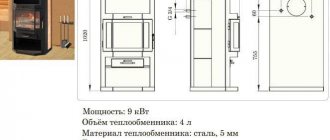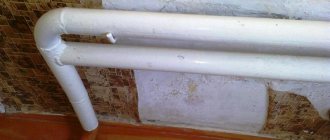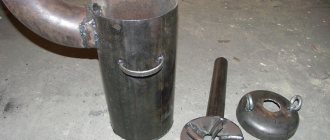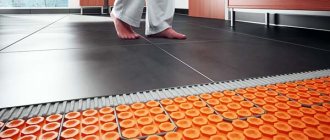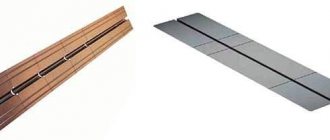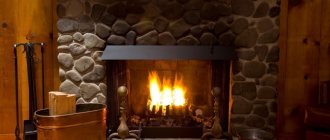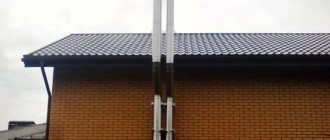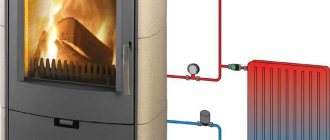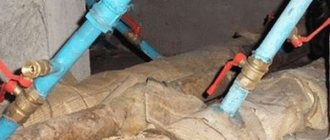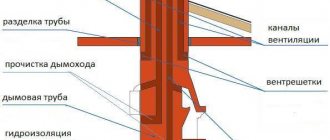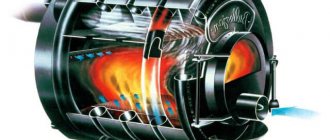Surely, you don’t know what difficulties you may encounter if you decide to use stove heating with a water circuit in a wooden house! There is a “hackneyed” stereotype that it is difficult to heat a house with a stove if you do not run a water circuit throughout the house, but this is not true! The water circuit in the furnace causes a lot of problems both during installation and operation.
In this article I will try to weigh the pros and cons, and it’s up to you to decide... And at the end I will show a short video from a real house under construction, where the furnace-boiler is made with a water circuit. We will talk about wood stoves.
Review of various schemes of water heating furnaces
One of the simplest stove designs with a U-shaped heat exchanger installed directly in the firebox. The heater with flat surfaces is made of 4 mm thick sheet metal; it is better to use heat-resistant steel. Another option is a coil in the form of a register, welded from pipes (possibly water and gas pipes) with a nominal diameter of 50 mm and a wall thickness of at least 3.5 mm. The figure shows a diagram of a water-heated furnace of a similar design.
Drawing of a stove with a built-in heat exchanger for water heating
1 – heat exchanger in the combustion chamber; 2 – door for cleaning chimneys; 3 - supply to the heating system.
The principle of operation here is simple: a steel register with a coolant is heated directly from the flame in the firebox, and the combustion products rush upward and make 3 strokes, simultaneously giving off heat to the brick walls and oven for cooking.
A slightly different stove for a home with water heating is a dual-purpose hob with a heater built into the firebox. The stove does not have long chimney channels, since it provides for the extraction of heat from combustion products by a water heat exchanger. The dimensions of the heat source are 1030 x 650 x 780 (height), the heater power is about 9 kW. The latter is made of pipes with diameters of 57 x 3 mm and 48 x 3 mm. The design of the furnace is shown in the photo.
Oven with hob
1 – firebox; 2 – ash chamber; 3 – door for cleaning; 4 – oven; 5 – hob; 6 – clay solution; 7 – water heater; 8 – chimney channel; 9, 10 – respectively, return and supply pipelines of the heating system.
The fuel, when burned, heats the coil directly. Additionally, it is heated by flue gases, which then enter the channel between the hob and oven, go around the latter and are discharged through the chimney. The heated coolant circulates from the register into the system, and the impulse can be either natural or forced. Thus, the water heater removes heat from the firebox and combustion products, cooling them to 150-200 ºС, due to which water heating from the stove is realized.
Despite all the advantages of such a design, there is an irrational grain in its work. The fact is that the combustion products, from which the hob warms up, are strongly cooled by the heat exchanger. It turns out that during cooking it is necessary to reheat the stove in order to warm up the hob, and at this time the water heating of the house will function at full capacity, and this is irrational and uneconomical. To limit the temperature of the coolant, you will have to install a buffer tank - a heat accumulator, otherwise in the autumn-spring period the rooms will become unbearably hot.
The two-chamber wood-burning stove with water heating by K. A. Dmitriev is devoid of the significant drawback described above and is considered the most common option in central Russia. It has separate chimney channels and two separate fireboxes - one for heating the oven and cooking floor, and the second for water heating from the stove. Separate chimneys at a height of 2 m are combined into one. The overall dimensions of the stove are 1500 x 680 x 770 mm (height), the developed thermal power is 9.5 kW, which is already significant, since it is enough for a house with an area of 100-120 m2. The design can be studied in detail using the drawings.
Structural diagram and cross sections of the furnace
1 – ash chamber; 2, 5 – combustion chambers; 3 – oven; 4 – ash pan door; 6 – cooking floor; 7, 8 — connection to water heating; 9 – heat exchanger; 10 – valve.
When the first firebox is operating, flue gases wash around the metal oven and enter the flue located underneath it. The water heater is not involved in the process, so this mode is convenient in the summer and transition period. In the cold season, a second chamber is heated, which is used only to heat a private home and does not affect the operation of the hob and oven. This version of the brick stove is optimal and economical, showing good results in the efficiency of burning solid fuels (efficiency - 50-55%).
Advantages of wood heating in the house
When choosing a heating method for their home, most owners compare all the options and research the benefits. Stove heating has the greatest number of positive aspects, among which the main ones can be identified:
- Environmental friendliness. This type of heating simply has nothing to compare with in terms of environmental friendliness, since heating a stove with wood does not cause any harm to the environment. When wood burns, exactly the same amount of carbon dioxide is released into the atmosphere as would be released when wood rots under natural conditions. And given that the timber industry is rapidly developing, such a volume of carbon dioxide will be absorbed very quickly.
- When heating a house with wood, a pleasant aroma appears that lasts for a long time.
- Stove heating is cost-effective, since firewood costs slightly less than other types of fuel.
- The unit can be used simultaneously not only for heating the home, but also for cooking. This is especially true in cases where the house is located far from the gas main.
- Heating a room with a wood stove is quite effective, but at the same time it is not complicated. If the stove is installed according to all the rules, then there will be no need to install radiators and other heating devices, the house will already be warm.
- The stove draft not only completely removes the products released during combustion, but also establishes excellent heat exchange between the room and the street. Thanks to this, humidity is normalized and a balanced temperature inside the house is achieved.
Of course, heating a private house in this way also has disadvantages, but they are not so significant:
- the need to regularly purchase fuel (firewood);
- you need to equip a place to store firewood.
Gas generator furnaces
Gas generator furnaces have a number of distinctive features:
- Economical. The stove operates for about 12 hours on one load of fuel.
- Compact sizes.
- High efficiency - about 85%.
- Possibility of adjusting combustion intensity.
- Possibility of using different types of fuel.
- Easy to connect water circuit.
It would seem that the choice in favor of gas generator furnaces is obvious. But before installing such a model, you need to evaluate a number of nuances:
- Essential requirements for the installation of a chimney.
- There is a high probability of condensation forming on the chimney walls.
- Manual adjustment takes some getting used to. Only in this case can all the above benefits be achieved.
- You can use different types of fuel, but there are a number of requirements, non-compliance with which can lead to a deterioration in the quality of heating.
Is it possible to install a heating register in an existing furnace?
It would be more correct, of course, to build the furnace around the manufactured register. But, if the stove is already standing, you can still build a water circuit into it. True, you will have to try hard - they are of considerable size and must somehow hold on. So the task is not an easy one. In addition, do not forget that you will have to make two more conclusions - to connect the supply and return pipelines.
The best option is to make a water jacket under the shape of the stove (this one is for a metal stove with burners)
Finding a place to locate the register is also not very easy. Its direct contact with fire is very undesirable, but it should be in an environment of hot gases. In this case, you can hope that the heat exchanger will last a long time.
How to build a water stove at home
- There are three ways to do stove heating with a water circuit with your own hands:
- buy a steel stove from a manufacturer whose services include system installation;
- hire a craftsman - a specialist will select the material, make the device, lay out the stove and install the boiler;
- do it yourself.
How to make such a stove yourself
The principle of a boiler for water heating
Can you make such a system yourself? Quite, just experience in welding and bricklaying when building a furnace is enough. First you need to prepare the boiler (register, coil, heat exchanger).
You can buy such a device or make it yourself using sheet iron and pipes. Since the full process of manufacturing and installing a water circuit cannot be summarized in a short review, the main recommendations are presented below.
Manufacturing options and recommendations
Water heating from a wood-burning stove - diagram
For the boiler, a sheet of metal with a thickness of at least 5 mm is used, and its design is made in such a way that there is maximum heating of the water for further circulation. The boiler, welded from sheet steel, is easy to manufacture and operate – it is easy to clean.
But such a heat exchanger has a smaller heating area, unlike a pipe register. It is difficult to make a pipe register at home yourself - you need an accurate calculation and suitable working conditions; usually such boilers are made to order by specialists who themselves install the system on site.
The simplest method of a solid fuel heat exchanger is a regular potbelly stove with a built-in water system. Here you can take a thick pipe as a basis, then there will be much less welding work.
Attention! All welding seams must be made double, since the temperature in the firebox is not lower than 1000 degrees. If you weld ordinary seams, there is a chance that this place will quickly burn out
Complete the register drawings in accordance with the dimensions of the stove at home. The layout of the rooms of the house and the arrangement of furniture also need to be taken into account.
Here you need to pay attention that it is better to choose a scheme with sheet-metal boilers - they do not have pipe bends connected into one continuous circuit. It is not so troublesome to build such a structure
It is also convenient because after installation you can use the hob without any problems, which is not the case with some tube boilers.
Register made of smooth pipes - drawing
When the coolant moves by gravity, you need to raise the expansion tank higher and use larger diameter pipes. If the pipes are of insufficient size, then you cannot do without a pump, since there will not be good circulation.
Boilers equipped with pumps have their pros and cons: you can save money by installing pipes of a smaller diameter and not raising the system so high, but there is one significant disadvantage - when the electricity is turned off or the circulation pump burns out, the heated boiler may simply explode.
It is better to assemble the structure at home, on site, since the device, like individual parts, has a very large weight and dimensions.
System installation
Heat exchanger made of cast iron battery
- Before installation, a solid foundation is poured, on top of which it is better to lay a layer of brick.
- The grate can be laid at different stages: before the boiler, if there is a double structure, the lower part of which can be equal to or higher than the upper part of the grate, when the stove is low and the system is placed a little higher, then the grate, doors, corner on the stove are usually installed after installing the boiler .
- The housing is installed - usually it consists of two containers connected to each other by pipes.
- The entire heat exchange system is welded to the boiler: the exhaust pipe goes to the expander, goes in a circle, through the radiators, and on the other side the return pipe is welded to the boiler from below.
Stove heating with a water circuit allows, firstly, to use firewood much more rationally, and secondly, to evenly distribute warm air throughout the heated room.
If you decide to make your own heating system at home with a water circuit using wood, think through all the stages of the work, and if you have doubts about the successful outcome, it is better to contact specialists.
A more complex water heating system using wood
It is a pyrolysis boiler. which consists of two sections. In the lower section, firewood is burned, and in its upper part, the gas generated during combustion circulates. Due to the fact that in this design, gases do not immediately enter the chimney, its efficiency is higher, and such a boiler consumes less firewood.
It is tied with thick-walled pipes through which water circulates, heated by the boiler.
It is necessary to take into account that for the normal functioning of such a boiler, it is necessary to use only dry firewood. If the farm has a pyrolysis boiler, then there should also be a supply of well-dried firewood.
There are systems that use hot air rather than water for heating. It passes along the circuit and is supplied to the living quarters. Cooled air, according to the physical law of convection, falls down, enters special air intakes and again enters the boiler.
Principle of operation
Units with a water circuit are equipped with a heat exchanger built into the firebox or chimney duct. There are models that can operate in steam circulation mode.
A wood heating stove can be made of boiler steel or cast iron, designed to operate under high steam pressure. These devices are used both as additional equipment and as the main heat source.
A heat exchanger is installed inside the furnace unit. Heated gases move through the channels of the heating reservoir, transferring heat to the liquid. A furnace with a boiler in its design can have several tanks at the same time, which can significantly increase its efficiency. Water is heated in one tank, and with increased heating, the process of vaporization occurs in the second.
To heat a large building with traditional furnace heating, several furnaces will be required, and the consumption of coal or fuel will be quite high. Therefore, a more economical and alternative option would be a stove for water heating a house using wood, equipped with a special hot water boiler built into the firebox. Even in severe frosts, heating the stove twice a day is enough for such a heating system.
Such devices are capable of heating the building even during breaks between fireboxes. During the cooling process, the pipelines give up their heat for another 5-6 hours, thereby providing heating without consuming fuel. Water heating from a wood-burning stove has an efficiency of 80-85%.
Stove with coolant
Stove heating of a wooden house in this case requires the presence of a coolant such as water. In essence, this is a combination of stove heating and water heating. Only the efficiency is increased, and the heat is distributed evenly throughout the room, which allows you to use fuel even more rationally.
Heating system with stove and gas boiler
The circuit with a water circuit has all the advantages that both stove and water heating provide. The water system is built into the stove - and therefore the heat in the room is distributed evenly. In addition, an important point is that thanks to the built-in water heating, you can heat several rooms at the same time.
6bfb0a833dbfe310c5af7dc81691ea0c.jpe 245fda58b0c5661202dc1e5a0022dc3e.jpe
Thus, in this case, stove heating of low-rise buildings is a kind of boiler that runs on solid fuel. The only difference is that along with the heating of the coolant in the stove, the smoke channels and walls will heat up. Heat will be transferred not only from the stove to the radiators, but also from the heated surface - directly into the room. Note that stove heating projects are made only for those houses that have no more than two floors.
Modernized heating system with stove
Tips for setting up the system
At their core, such designs are the progenitors of modern solid fuel boilers. But unlike them, heat transfer is carried out not only through piping and a radiator system, but also from the stove itself.
Plus, installing brick stoves with water heating yourself is much easier and cheaper than installing a solid fuel boiler.
A few words about the register
Without exaggeration, the metal register can be considered the heart of the entire heating system. This design is installed directly in the firebox itself and is responsible for the heating level of the coolant.
Lateral arrangement of registers.
The simplest and most affordable option is to install a rectangular metal tank directly into the firebox. Such a tank is made of heat-resistant steel, with a thickness of 3 mm or more, most often from stainless steel.
To heat a house of 200 m², a tank 750 mm long, 500 mm wide and 300 mm high is sufficient. The outlet is made from the top of the structure, the return line cuts into the bottom of the tank.
Registers welded from stainless steel pipes with a wall thickness of at least 3 mm are considered more functional. In this case, the heating area increases several times, hence the efficiency of the system is disproportionately higher.
Advice: it is not difficult to find cast iron registers on the market now; according to most experts, they are the best option. Firstly, cast iron is little susceptible to corrosion, practically does not burn out, and most importantly, this material is considered the best heat accumulator.
Stainless steel registers.
During installation, pay attention to the location of the register. The more contact with fire, the higher the productivity
But at the same time, regardless of the configuration of the tank, there must be a compensation gap of at least 5 mm between it and the walls of the furnace. Otherwise, during heating, the metal will begin to expand and the walls of the firebox will crack.
Diaphragm tank
Installing a register into the firebox is only part of the story; it is equally important to properly arrange the piping. Any heating system built on this principle must be equipped with an expansion or membrane tank
As a rule, it is installed on the return pipe, but this is not important; some craftsmen prefer to mount it at the highest point of the system.
Operating principle of a membrane tank.
In a system with natural coolant circulation, its function is performed by an ordinary metal container. But now, in most cases, owners prefer to install circulation pumps. It is advisable to install a real membrane tank in such a system.
The device is a sealed metal container, in the upper part of which there is a valve. Air is forced through the valve, creating excess pressure in the system. As the temperature rises, the coolant expands proportionally, squeezing the excess into the membrane tank. During the cooling process, the air that presses on the membrane compensates for the pressure drop in the system.
Some aspects of laying a furnace
As mentioned earlier, you can build water-heated brick stoves with your own hands, but if you are not confident in your abilities, it is still better to invite a specialist.
Although in any case, there are general rules that it is not advisable to break.
- All brick ovens are made of solid red brick. It is not advisable to use hollow brick even for cladding. The fact is that hollow blocks are a heat insulator, and in this case this can only do harm.
- If you plan to burn with wood, then the firebox can be made of ordinary baked brick. But if there is a possibility of using coke or high-grade coal, such as anthracite, then we would advise making the firebox from special fireclay bricks, which are used in the construction of blast furnaces.
- There is no need to save on wall thickness; in addition to the weight of the oven itself, the load from the registers will also be added here.
- And yet, any stone structure needs a reliable foundation; as for stoves, the foundation should be laid separately and in no case should it come into contact with the general foundation of the house, the minimum distance between them should be 50 - 100 mm.
Circulation pump in the system.
The video shows some of the intricacies of installing the system.
In this case, we were talking about heating a house. But it is worth noting that if a metal water container is inserted into the system in parallel, it will act as a passive boiler, as a result of which hot water will still appear in the house for domestic needs.
What size house can be heated with a brick stove with a water circuit?
A brick stove can also be adapted for heating large areas if, when building it, a heat exchange element is placed near the firebox through which the coolant will pass, heating up and then circulating in the heating system distributed throughout the house. In this case, you may need to connect a water pump, which will accelerate the movement of coolant in the system.
Homemade efficient heat exchanger
Heat exchange elements can be of different shapes; the photo shows one of them. It is embedded in the structure of the stove near the combustion chamber so that, passing through it, the water quickly heats up and enters the pipes and radiators.
The inlet and outlet pipes from the heat exchanger are led outside the furnace structure, and the heating circuit is connected to them. Next, the system is filled with water, which will act as a coolant.
Wiring can be done using metal-plastic or polypropylene pipes
In this case, metal-plastic pipes are used for wiring and connection to the circuit.
Diagram of a wood stove with a water heating circuit
In this diagram, the heat exchanger is located above the firebox and is shown as a red grate. The blue line marks the cooled coolant, which passes through the circulation pump and enters the heat exchanger - this part of the circuit is called return. The red line marks the heated water entering the radiators.
A membrane tank is also installed in the heating circuit, which can be located in any accessible location in the circuit, but it is advisable to install it on the return pipe.
Diaphragm tank
It is also called a closed expansion tank. There is a nipple on its upper part, through which air is pumped into the upper chamber. When water in the system heats up, it expands and excess water rises into the tank, stretching the membrane. When cooling and the corresponding pressure drop, water is pressed back into the system. In this way, possible pressure surges in the pipes are smoothed out, and the risk of destruction of the integrity of the system from overheating is minimized.
Video sketch: an interesting version of a fireplace stove with a heating circuit
System Features
A conventional brick stove consists of components such as a combustion chamber, an ash pan, grates and chimneys. These components of a simple Russian stove are probably familiar to any village resident. Visually, modern types of stoves are practically no different from traditional village designs.
Main characteristics of water-heated furnaces
Traditional ovens have the following characteristics:
- A simple village stove can produce more than 6500 Kcal of heat in one hour. This amount of heat is quite enough to heat a house with a small area. Such a heating system would be an ideal solution for a small country house. A water-heated furnace, in which the main component is a water boiler, will be approximately 2.5 times more efficient. Using such a heating system, you can heat a house with a much larger area. In order to heat a house, the same amount of fuel will be required, which means that such a system will be more economical.
- A heating system that combines a stove and a boiler will also be effective. If both systems work simultaneously, their productivity increases many times over. A tandem of two such heating systems can release more than 21,000 Kcal of heat in one hour of operation. This amount of heat is enough to heat a house with an area of up to 300 square meters. meters.
Stove connected to water heating
- Most often, such a heating system uses fuel such as coal or wood. The price of such fuel is not high, and its transportation should not cause any particular difficulties. Firewood can be combined with coal at the same time.
- There is no need to constantly heat water-heated stoves. Fuel can be added to the stove several times a day. You can create comfortable conditions indoors, no matter what the weather or temperature is outside.
- If we compare the efficiency of traditional stove heating with a combined system, this figure will increase from 50% to 85%. For heating with wood, this figure can be called ideal.
- The materials that are necessary to organize such a heating system are quite affordable and are not included in the expensive price category.
Disadvantages of water-heated stoves
Stove heating also has its disadvantages, and it would be unfair not to list them.
A brick stove with water heating can be installed not only in a rural or country house, but also in luxury cottages. Typically, owners of luxury homes strive to ensure that such a water heating stove, in addition to its usual functions, also plays a decorative role. During operation of such a combined system, it is necessary to follow some safety and system care rules:
A stove for water heating at home must be under human control at all times.
This applies not only to the issue of loading fuel, but also to cleaning the ash chamber. Smoke ducts also require attention. Before starting a fire in the lever, you must make sure that the smoke channel valves are in the open position. Such systems can only be used in the cold season
During the warm season, using such a heating stove with a water circuit for cooking will be impractical. If you need to cook food, it is better to use another alternative heat source for this purpose.
If you want to make custom-made stoves for water heating at home, it is better to turn to professionals for help. If your stove is manufactured by an unqualified person, there is no guarantee that the stove will function properly or be completely safe. Overheating of the oven can cause some problems that will eventually lead to complete breakdown of the oven.
A conventional stove is usually designed to heat a small room
Since the flame has high temperatures, it will eventually damage the integrity of the boiler walls. This means that the time will come when the heat exchanger will need to be replaced. This is not so easy to do, since you need to remove a good part of the masonry.
Advantages and disadvantages of water heating
There are two heating options:
- heating is carried out with natural air circulation;
- with forced movement of the coolant.
Each type of heating has both its disadvantages and advantages. For example, for the first one to work, it is not at all necessary to have a power supply (you must agree, this is a good option in a remote village where electricity often goes out). However, the design is very capricious in terms of calculations and the accuracy of the installation work performed. When installing it, it is extremely important to maintain the required angle of inclination. The boiler tank itself must be placed at the lowest point.
The second type creates a flow of water from running electric pumps. It should be noted that compared to the previous heating option, this one has a higher efficiency.
Integrating a stove into an existing heating system
If you already have a heating system that has previously been used with a different type of heating, you can connect a furnace to it. For example, it can become a replacement for a gas boiler.
Modern heating equipment usually does not contain a heating tank. But, it has a heat exchanger that performs a similar function.
The cost depends on a lot of factors - material, size, efficiency, maximum permissible heated area, etc. Moreover, there are models that allow not only to heat the house, but also to provide a full-fledged hot water supply system.
Factory stoves usually allow the use of both classic wood and coal, and pellets, which is a compressed wood material used as fuel.
How to properly heat a wood stove in a wooden house
How to properly heat a wood stove in a wooden house
How to properly heat a stove with wood in a wooden house, as efficiently as possible, and so that the stove doesn’t crack and you don’t get burned?
General procedure
Lighting up wood stoves begins with checking them and cleaning them from ash and soot. This stage is general and mandatory, regardless of the design and volume of the firebox; without air access, the firewood simply will not burn. After that:
1. Paper and thin dry wood chips are placed on the cleaned grate, ignited with the combustion door or its damper open and the view and ash pan closed.
2. After ignition, thick logs are laid on top of the burning splinters in even horizontal rows or a pyramid, filling from 1/3 to 2/3 of the volume of the firebox. The fire door closes, the view and the ash pan, on the contrary, open completely and remain in this state until the firebox is completely warmed up and an even golden flame appears.
3. When the firewood is completely ignited (all the logs are engulfed in flames, the flame turns from blue to yellow, the stove hums steadily), the combustion process is prolonged as much as possible, the draft is regulated using the lower dampers. If the draft is too strong, the blower closes with a gap of 1-2 cm or completely.
Further actions depend on the planned number of bookmarks, wall parameters and the initial temperature in the house.
Very cold and rarely visited wooden log houses are heated with at least 3 loads of firewood; with daily heating in the stove, only one large portion of firewood can burn out.
Accordingly, if additional refilling is necessary, the condition of the logs is monitored, the second portion is placed on burnt but not cooled coals collected towards the middle of the grate.
ATTENTION! A brick stove can be easily overheated and it will crack, so approach this responsibly and follow the recommendations. Under no circumstances should your oven become too hot to touch. And it is important to understand that the stove does not warm up immediately, so make small piles of firewood evenly.
Instructions for building a stove heating system with a water circuit
- A hole is being dug.
- A “cushion” is laid, consisting of broken bricks, crushed stone and medium-sized rubble. The width of this layer is approximately 20 cm. Natural materials are compacted and filled with cement mortar.
- Bricks are being laid. It is laid in two rows on cement, and covered on top with a waterproofing layer of roofing felt, parchment and roofing felt.
- A brick foundation is being built with clay mortar.
- The first continuous row is laid. In the second row, an ash chamber begins to form, for which a special door is installed. The third row repeats the previous one.
- The fourth row is formed. It serves as the basis for the fuel chamber made of refractory bricks; grooves are provided on it for installing the grate.
- A U-shaped boiler made of steel is installed. Two pipes are welded to it - one at the top for supply, the other at the bottom for return. It also has a rectangular hole through which heated gases will escape.
- The fifth row is laid. It is necessary to provide channels behind the side and rear walls of the boiler. Two small doors are installed on them to remove soot.
- A sixth row is formed, in which a hole is provided between the gaps made in the previous row. This is a suction channel to increase draft in a heating furnace. The door for the fuel chamber is also installed here.
- The wall is being laid out. It should be taken into account that fire-resistant bricks are laid around the door leading into the combustion chamber and above the fuel boiler.
- Cast iron stoves are being installed on which food can be cooked. A metal corner is attached to the entrance of the heating and cooking chamber.
- Chambers are formed, a channel is made on the back surface, and doors are installed.
- The facade of the cooking chamber in the 16th row is covered with a metal strip. And then it itself is covered by laying bricks on specially laid metal strips.
- A steam exhaust valve is installed to ventilate the furnace and an upper flue is formed.
- 35 rows are laid, on which the construction of the chimney begins.
Some people want to use a ready-made stove or fireplace, combining it with a water circuit. In this case, you will have to disassemble them almost to the ground in order to install the register.
Mayevsky crane
Potbelly stoves
In small country houses or outbuildings, the simplest units that run on wood are often installed: potbelly stoves. They are small and uncomplicated in appearance. They are rectangular or cylindrical buildings, which have a firebox, an ash pan and a chimney that goes upward. Of course, you can’t put them in a renovated house. But they are not pretentious and inexpensive, they provide a lot of heat. A potbelly stove with a water circuit is also popular, as it is very practical.
The design of the “bourgeois” is simple: only two chambers. Fuel burns in one chamber, ash and ashes spill into the other, which need to be removed from time to time. There is a special door for this. It also helps regulate the air supply. The wider the open, the stronger the draft, and, accordingly, the more intense the combustion. You can load not only firewood into the firebox, but also coal. The smoke goes into the chimney channel.
Advantages of "bourgeois":
- these models are very cheap, as they are simple in design and do not pretend to have a special design;
- it is possible to make the unit yourself from available materials (the main thing is to find a heat-resistant metal, you will also need the ability to hold welding equipment in your hands);
- the construction of a foundation is not required; a sheet of asbestos or metal is enough.
That is, a potbelly stove is a good choice from the economy series of wood-burning stoves for the home.
How the system works
The simplest water circuit is with natural circulation of water flow. Its basis is a simple physical phenomenon: the expansion of liquids when they are heated. The unit that creates pressure is an expansion tank (a container for collecting water), installed in the attic or attic.
The water circuit is a closed system. The boiler heats the water in it and, expanding, it is directed through a pipe into a storage tank. The movement is carried out under pressure created by the cooled water constantly entering the boiler and passing through the entire system. Boiling water from the expansion tank is directed by gravity down through the pipes leading to the batteries. Having given off the heat, it returns to the tank and heats up again.
Installing a pump will help to significantly increase the pressure in the system and speed up the circulation of the coolant. At average outdoor temperatures, it can be turned off and the circuit will function on the natural movement of water. This will save you on your energy bills. Water enters the pump with the check valve closed. By turning it off (leaving it open), the entire volume of coolant is directed to bypass the pump.
Such a stove can be loaded not only with wood or coal. When using alternative fuels, it is possible to complicate the structure of the system by adding:
- granule storage tank;
- a mechanism that feeds pallets into the firebox (pneumatic or auger).
You can make the operation of the furnace easier by installing an automatic system for regulating its operation and forced ventilation.
Creating a heating wiring diagram
You can combine a stove with a water heating boiler and connect the circuit to the heating system using two schemes.
Open system
With an open system, the expansion tank is located at the highest point - in the attic; you can include a pump in the circuit
The coolant moves by gravity, so the installation of a circulation pump is required. It is placed on the bypass, reduces the temperature difference between the return and supply, increases the speed of water movement and the quality of heat transfer. Without electricity, the line will operate on the principle of gravity.
To organize it, you will need to increase the line and horizontal slopes in diameter. The open system is equipped with a 32 mm distribution manifold with a slope of 3 to 5 mm per linear meter. The expansion tank is located at the top; air enters it from the communications.
Closed system
The radiator network provides for forced movement of water. The thrust in this case is created by a pump. It also pumps up pressure from 1 bar for cold coolant. The membrane-type reservoir is located at the bottom. A shut-off valve is used to connect it to the main line. Safety devices (air vent, pressure gauge, drain valve) are required.
Masonry and brick
Stove maker is a profession that has been known since ancient times. Masters of masonry have always enjoyed special respect among all categories of the population. A qualified craftsman will create a unit such as a Russian water-heated stove, which will always have an evenly heated surface and excellent traction.
There are several main rules that must be followed by all specialists in this field:
- The combustion chamber must be made only from materials that are distinguished by their fire-resistant properties. If the fire escapes from the hearth, it can damage even ordinary brick or stone.
- When laying the walls of the stove, there is no need to skimp on materials. If the walls are laid with a quarter of a brick, this can significantly reduce the reliability of the entire structure.
- The tightness of the seams also requires special attention. If you leave even a small gap, carbon monoxide can then escape through it, and this can be very dangerous to human health.
Brick stoves with water heating today are modern equipment that will effectively heat your home.
https://youtube.com/watch?v=CZiTLx_zq5c
How to ensure optimal temperature conditions
When heating wooden houses with traditional stoves, obvious uneven heating is observed. The warmest areas in such a house are located in close proximity to the brick heater. It can get quite cool in the far corners. The multi-oven option is very expensive. In addition, this leads to a significant reduction in living space.
The most optimal solution is to use a combination of a brick stove with water heating. Many residents of our country already have similar experience, having managed to solve the problem of creating warmth and comfort in their homes. To do this, a conventional brick oven is equipped with a heat exchanger that looks like a coil. The place where it is installed is the firebox or the base of the chimney. Thanks to the heat generated, the water inside it begins to heat up, subsequently entering the radiator system. In this way, uniform heating of the home is achieved.
Advantages of a stove with a heating circuit:
- Efficiency and uniformity of heating. This is facilitated by the location of radiators in different rooms and the constant heating of the coolant.
- Absolute independence. These designs do not depend on the presence of gas and electricity in the house. In this case, the owners themselves choose the time and intensity of heating.
- Possibility of independent maintenance of heating systems. To carry out these simple activities, the presence of specialists is not required.
- Economical. Although such a system has to be started every day, due to the cheapness of fuel, the costs of its operation are quite small.
The weak point of such systems is their high fire hazard. For this reason, premises must be additionally equipped with fire protection. You should also take into account the fact that the heating device is static: it will not be possible to move it from place to place. A stove with a water jacket is capable of heating a small one-story house. If a building has a second floor, it is necessary to resort to the construction of another furnace, which results in considerable costs. Disadvantages of the system also include the need for constant human control.
Positive and negative aspects of stove heating in a private house
In most cases, stove heating is installed if necessary, in the absence of main natural gas. But heating with a stove has its advantages and disadvantages, which it would also be nice to know about.
What are the disadvantages?
Negative points include:
- It takes quite a long time to heat up the stove, and therefore the premises. This occurs due to prolonged heating of the walls and coolant in the system.
- Not very high efficiency of a brick building. To increase it, you have to build a higher chimney, make it a labyrinth type, so that the heat remains inside the structure longer.
- A brick stove occupies a fairly large area, but only on such a scale is it capable of heating several rooms at the same time.
- Unlike heating with natural gas, the stove must be supervised throughout its entire combustion, since brick options require constant addition of fuel. Long-burning cast iron stoves are an exception, since firewood is added once per burning session.
Positive points
Stove heating also has many positive qualities, which are often decisive in choosing it for installation in a private home.
Choosing a heating system depending on the size of the house
- For small, well-insulated houses, consisting of one or two rooms and a kitchen, one heating and cooking stove made of brick will be sufficient.
- For larger buildings, it is necessary to carefully consider the heating system so that the entire house can be heated from one stove. For this purpose, heating is used using a water or steam circuit.
- For a one-story building, such a circuit can be connected to a brick stove or one made of cast iron. When installing a system in a two- or three-story house, a cast-iron stove-boiler is more suitable.
The next thing you need to decide is the type of fuel. The system can be heated with wood, coal, peat, gas, diesel, electricity or several of them. This choice will determine which heating stove to purchase.
Installing a coil on a pipe
This is an excellent and fairly simple way to increase the efficiency of the stove. Flue gases heat the pipe to extremely high temperatures. The outer coil, like the inner one, helps reduce the temperature and somewhat cool the outer surfaces of the chimney. An external water heat exchanger is especially often installed on metal chimneys. This is an excellent auxiliary device for heating small spaces.
This heat exchanger has two pipes. The top one is connected to a pipe going to the storage tank, the bottom one is connected to the heating circuit. It is easy to make such a structure, as well as attach it to a pipe.
Recommendations for carrying out construction activities
When constructing a stove with a hob and a water circuit, the following standards must be adhered to:
- The stove and nearby surfaces must be separated by a safe distance. For these purposes, a metal sheet is additionally installed in front of the firebox to protect the floor and partitions.
- To make the masonry as strong as possible, every 4th row of bricks is reinforced with metal pins.
- A clay mortar of medium plasticity is used as a mounting mixture. A small ball rolled from it should not crack or crumble when it hits the floor.
- The chimney must have a height of at least 5 m: the presence of a head is a prerequisite. This element is designed to protect the chimney from climatic precipitation and blockages. In addition, it helps to increase traction and decorate the building.
Building a home stove with a boiler with your own hands usually does not cause any particular difficulties. Quite often you can find metal structures that are not inferior to brick ones in terms of external aesthetics. Such a product can greatly decorate a home interior. For the construction of brick kilns, a special building material is selected. The best option is fired ceramic red bricks. They are distinguished by their uniform color and metallic sound when tapped.
It is not recommended to take risks with burnt and unburnt elements, because... in this case, there is no guarantee of quality and operational safety. In fireboxes with very high heating levels, it is recommended to use a refractory refractory material, which usually does not cause problems during operation.
Preparation and selection of installation site
To begin, lay out all the materials in front of you. But we do this at the place where the stove is installed. We choose the latter like this. For maximum efficiency, the heat generator is mounted in the corner of the room so that the heat spreads across 2 walls and is not lost in 4 directions.
In this case, it is necessary to leave a small gap from the walls, equal to approximately 150 mm. If the stove is used in a country house, it is advisable to provide a chimney during its construction and run the upper section of the pipe through the roof.
There is no need to lay a foundation for our unit, because with the given parameters the weight will be small. If the stove is planned to be massive, then it is better to prepare a concrete base.
Calculation and design of the heating system
The main principle of calculation is that the heating system must compensate for the heat loss of the house. Therefore, first of all, heat losses are assessed, on the basis of which the power (kW) that will be required to heat the house is determined. It is impossible to perform such a complex thermal engineering calculation on your own. If it is not possible to entrust the calculation to engineers, you can try to perform it using special programs: Auditor OZC 6.9, nanoCAD otoplenie, VALTEC H2O. Or you can trust the practical experience of heating engineers and assume that for every 10 m2 of area of a heated building, 1.2-1.5 kW of heating power is required. Based on the calculations, a drawing of the heating system is made, which indicates the location of all elements and the movement of the coolant.
Firewood consumption
Theoretically, the amount of firewood required for the winter is calculated based on the average daily consumption rate (≈50 W/m2), the area of the heated part of a wooden house and the number of days of the heating season (in central Russia - at least 7 months).
To that obtained after dividing the total required amount of kilocalories by the amount of heat generated by the wood and its cubic density, add at least a 10% reserve for extremely cold days; ideally, owners of wooden houses prepare firewood for several seasons at once.
In practice, this value directly depends on the volume and type of firebox (fireplace stoves, long-burning models, potbelly stoves and masonry structures are heated in different modes), humidity and type of wood, duration of combustion and intensity of operation of the stove.
Maximum heat transfer is achieved when heating wooden houses with birch, maple, beech, oak, average - when laying logs of fruit trees or well-dried conifers (but the latter release a lot of resin and burn out quickly), minimum - when using low-density wood (poplar, linden , aspen).
Daily heating of a wooden house of average size requires about 20 kg of dry firewood; if the walls are poorly insulated or attempts are made to warm up rarely visited cottages, this amount increases significantly.
To optimize consumption it is recommended:
• Place firewood in the firebox of the same size (ideally with a thickness of 6-10 cm, no less due to the rapid burning of splinters, and no more due to the formation of coals that smolder for a long time and give off little heat) and type (the only exception is made for mixtures of dense wood with 2-3 large chips of alder, allowing wood to burn without soot).
• Select the length and cross-section of the logs to match the size of the firebox. Optimal results are achieved with a one-time full load of the stove after ignition, dense but ventilated stacking of firewood with a gap of 2-3 cm between each other. The exact requirements depend on the design of the stove, but in most designs it is recommended to leave the upper 20 cm of the firebox or the area at the entrance to the chimney free. Kindling chips are placed closer to the door, large logs - vice versa.
• Have at least a daily supply of dry firewood in the house. The average amount of heat released by well-dried firewood is 4500 kcal/kg; for damp logs this figure drops by half. Freshly cut firewood does not burn at all, it slowly smolders and clogs the chimney with soot.
• Promptly clean the interior of the stove and chimney from soot and take measures to protect against its accumulation.
• Control the activity of firewood combustion by opening or closing the corresponding dampers (the firebox and ash doors regulate the supply of fresh air, the view and smoke damper regulate the draft). Lack and excess of oxygen are equally undesirable; with a small air flow, the firewood burns incompletely, releasing less heat and more soot; if the flame is oversaturated, most of the heat flies out into the chimney and the firewood burns out too quickly. It is easy to distinguish between the modes - with a limited proportion of air, the flame has a burgundy color and the walls of the stove quickly become covered with soot due to a cloud of black or white smoke; with an excessive ratio, a white and bright flame hums in the firebox, and the firewood itself crackles loudly.
Types of wood stoves
With all the variety of wood-burning stoves, they can be divided according to their purpose into several groups:
- cooking and heating;
- stoves fireplaces;
- sauna stoves.
Traditionally, wood stoves were made of brick. This material resists high flame temperatures well, and when heated, it releases heat into the room for a long time. If you have certain knowledge and skills, you can build a brick oven with your own hands.
Over time, metal units appeared, for the manufacture of which steel or cast iron is used. They are much more compact than brick ones, but do not accumulate heat well and, in most cases, are able to heat the room only during combustion.
Cooking and heating stove on wood
Such a wood-burning stove is suitable for both heating and cooking.
A cooking and heating stove, as the name suggests, is used not only for heating, but also for cooking and heating water. Such options, built of brick, are very massive and can combine a heating panel, a cooking stove and a stove bench. In addition to the stove, an oven can be installed, which will be used both for preparing baked goods and to improve heat transfer.
A heating and cooking stove is usually installed in the middle of the house, away from the outer walls. This is done in order to maximize the use of heat from the housing to heat the air in the room. Sometimes partitions are adjacent to the furnace, dividing the building into rooms. In this case, the stove is oriented so that the firebox, stove and oven are in the kitchen area, and the stove bench and heating panel are in the room.
Russian wood stove
A classic example of a cooking and heating system is the Russian stove. Such stoves have long been built in huts. These massive structures were installed in the middle of the home to ensure uniform heat exchange in the room. The large firebox was used in different ways - they cooked food in it, like in an oven, dried fruits, vegetables and mushrooms, and even washed and steamed inside it. On the couch equipped at the top, it was possible to warm up the body, which had a beneficial effect in the treatment of colds, diseases of the joints, and ligaments.
Stove fireplace
Combined fireplace stove
This heating structure combines two heating devices. The result is a very effective “tandem”. The fact is that the stove itself, installed in the living room, may look unattractive. Another thing is a fireplace, in which wood, burning with a bright flame and crackling at the same time, creates warmth and comfort in the room. But using the fireplace itself for heating is ineffective. It emits thermal radiation into the room only when wood is burning. And this is only a small part of the total heat generated from the combustion of wood. The main part “flies into the chimney”, since very good draft is required to fire the fireplace.
A fireplace stove is a rather massive structure into which a fireplace insert is built, usually closed with a door made of heat-resistant glass. When wood is burned in such a firebox, the draft can be reduced, and the flue gases, passing through the array, heat it up.
Bath stove
Sauna stove
Sauna stoves can be used. simultaneously performing several tasks:
- heating the bathhouse;
- heating water;
- heating the stone backfill.
Such stoves can be made of brick or metal. The water tank is built into the array or mounted on a metal pipe. Sometimes the tank is mounted separately, connecting it with pipes to a heat exchanger built into the furnace. Heated stones are used in a traditional Russian steam room, pouring water or various herbal infusions over them.
